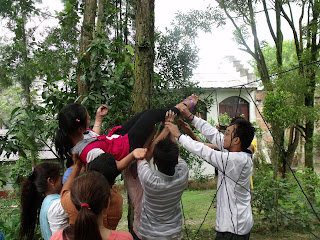Living in Nepal certainly makes you realise how we take so much for granted in our day to day lives in New Zealand (the same goes for all developed countries)… The people here work very hard for very little. This is of course a generalization, as there is great variation between life in the city and life in the village, or life for the (relatively) well off and the poor.
The government here is both corrupt and politically unstable. Nepal has no constitution, and after 3 years of working towards one (since the elections were held at the end of the civil war) the population is fed up with the lack of progress. The government does very little, from infrastructure development, to delivery of services and enforcement of law. Communities need to work together to provide everything from education for the children, safe drinking water and healthcare to development and maintenance of roads and infrastructure.
It constantly amazes me the number of people we meet with a vested interest in improving the lives of the Nepalese people. Eager young Nepali men who choose to work on the development of their community, rather than pursuing opportunities abroad. The spirit of NGO’s and community service clubs is very strong here, everyone is involved in some project; from micro-finance co-operatives, to establishing disability centres and schools, to improving water supplies and providing literacy and vocational training to those who need it.
Still despite the active involvement of members of the community in development projects, there is still a lot of work that needs to be done. Some examples;
- Rubbish collection is virtually non-existent. Rubbish litters the street and destroys the scenic beauty of the trekking routes. There are a few rubbish collection systems in place in Nepal. But even when collected the rubbish is simply dumped on a massive pile resulting in both an eyesore and pollution, with leaching of waste into the adjacent fields and water-ways.
- Water. We have definitely come to appreciate a hot shower. Lok’s house has solar panels, but even so a hot shower is a rare luxury. The tap water is not safe to drink. Yet we are lucky, many homes have no running water at all. Even Ashok who lives next door must carry water up to his house. In the villages it is not uncommon for people to walk several kilometers for water.
Women collecting water in Bhaktipur (city of around 200,000 outside of Kathmandu)
- Roads that are tar-sealed and maintained. In recent years the Nepali government has been very active in bull-dozing roads to the villages. This is great to enable better access to markets and healthcare and education. However, the roads have been carved into steep hillsides and with the monsoon rains they quickly become impassable. Landslides commonly block or wash away the roads, as well as deep rutted erosion. The roads are built but maintenance is very limited. Even the main highways to China and India (which are actually tar-sealed) are full of potholes and landslides.
Women greeting us carrying loaded doko
- Physical labour. It is very common to see women and young children carrying heavy loads from the fields. Dokos are carried on the back, supported by a strap around the forehead, usually full of fodder for the animals or water canisters. Full bags of rice are also carried like this. Some children do not go to school because they are working in the fields. - Health. It is heart breaking to see the people suffering due to lack of proper health care facilities and financing. Like Sumina we met in Baluwa Village with a broken arm – she never went for treatment despite the pain. Like the many women we have heard about suffering from Uterine Prolapse. This is shockingly common in rural Nepal, and many live with it for years. We will touch more on this later.
- Housing standards. In the villages, people live in homes usually constructed from mud or stone. Windows are covered by shutters, not glass. You cannot escape the dirt, as this makes up the floors and walls. Villagers who own goats, buffalo or cows will usually have them living with them inside the home. Cooking is done over a small fire, or gas stove sitting at ground level. There are no freezers, or fridges. Everything is prepared fresh. There are no washing machines either. It is all done by hand. Even where we live, in the big smoke of Banepa – with around 40,000 people, there are few washing machines. Sufficient water supply to use the machines is an issue.
Bio-gas stove in village home
Our home in Banepa
- Education leaves a lot to be desired. Not all children go to school, some because they cannot afford the cost of the school uniform as the school is free, others because they are required to work to support the family. Many of those that do go to school attend a government school. Pass rates at these schools are low with ill-qualified teachers, limited resources and poor facilities. Good schools are expensive, attainable only for a few.
This is not a comprehensive list and we will touch on more on these issues in the future. In the meantime I urge you to appreciate the good things in life (that we rarely even think about) as they are by no means guaranteed to us all. Perhaps next time you open the tap for a drink of water…

































